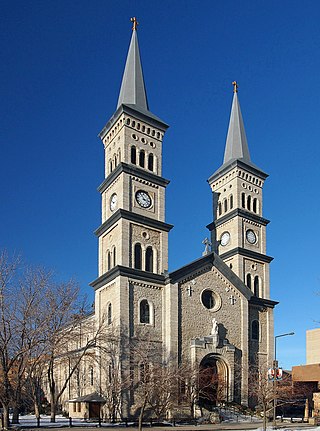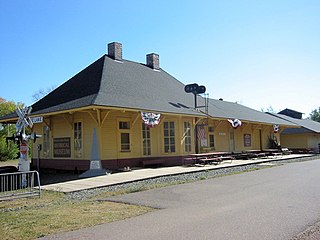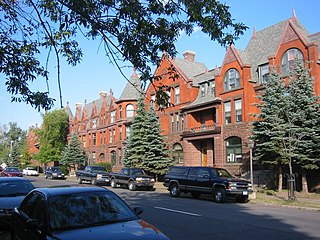
The College of St. Scholastica (CSS) is a private Benedictine college in Duluth, Minnesota. Founded in 1912 by a group of pioneering Benedictine Sisters, today St. Scholastica educates almost 4,000 students annually and has graduated more than 29,000 alumni. The college offers a liberal arts education and is located on 186 wooded acres overlooking Lake Superior.

The downtown of Duluth, Minnesota, United States, is situated between Mesaba Avenue and 4th Avenue East; and located on Michigan, Superior, First, Second, and Third streets.

The Minneapolis Armory is a historic event center and former National Guard armory located in downtown Minneapolis, Minnesota, United States. Built by the Public Works Administration in 1936, the building was occupied by several Army and Naval Militia units of the Minnesota National Guard from its opening until 1985. The building is listed on the National Register of Historic Places.

The Chicago, Milwaukee, St. Paul and Pacific Depot Freight House and Train Shed, now officially named The Depot, is a historic railroad depot in downtown Minneapolis, Minnesota, United States. At its peak, the station served 29 trains per day. Following decline, the station was closed and eventually adapted into various other uses.

Clarence Howard Johnston Sr. was an American architect who practiced in the US state of Minnesota during the late 1800s and early 1900s. Specializing in domestic, religious, and public architecture, he served as Minnesota State Architect from 1901 to 1931. He is considered one of the most prolific architects in the state's history.

The F. Scott Fitzgerald House, also known as Summit Terrace, in Saint Paul, Minnesota, United States, is part of a group of rowhouses designed by William H. Willcox and Clarence H. Johnston Sr. The house, at 599 Summit Avenue, is listed as a National Historic Landmark for its association with author F. Scott Fitzgerald. The design of the houses was described as the "New York Style" in which unit was given a distinctive character found in some rowhouses in eastern cities. Architecture critic Larry Millett describes it as "A brownstone row house that leaves no Victorian style unaccounted for, although the general flavor is Romanesque Revival." The Fitzgerald house is faced with brownstone and is two bays wide with a polygonal two-story window bay on the right, and the entrance, recessed under a round arch that is flush with the bay front, on the left. The mansard roof has a cross-gable with two round-arch windows and decorative finials.

The Church of the Assumption Catholic Church was dedicated in 1874 and is the oldest existing church in Saint Paul. It is located at 51 West Seventh Street, in downtown Saint Paul. The building is listed on the National Register of Historic Places.

The Church of Saint Agnes is a Catholic church of the Archdiocese of Saint Paul and Minneapolis. The parish was founded in 1887 and the current church building was completed in 1912 and listed on the National Register of Historic Places in 1980.

The St. Paul Women's City Club is a 1931 Art Deco Streamline Moderne-style Mankato limestone clubhouse in Saint Paul, Minnesota, that was designed by architect Magnus Jemne (1882-1964). The building was designed to provide a "center for organized work and for social and intellectual intercourse", and provided a dining room, assembly rooms, dressing rooms, and bedrooms for the 1000 members of the club and their guests. The building was sold to the Minnesota Museum of Art in 1972 and now houses an architectural firm. It is listed on the National Register of Historic Places.

The Church of St. Wenceslaus is a Catholic church in New Prague, Minnesota, United States, constructed in 1907. The church is flanked by a 1908 rectory and a 1914 parochial school, and the three-building complex is listed on the National Register of Historic Places for its association with the Czech American settlement of south-central Minnesota.

The Minneapolis Public Library, North Branch building is a former library in Minneapolis, Minnesota, United States. It was designed in 1893 by architect Frederick Corser. When it was opened, it was claimed to be the nation's first branch library to have open shelves so patrons could browse for books on their own, without asking librarians to retrieve them. The library set a precedent for future library development in the Minneapolis Public Library system.

Oliver Green Traphagen was an American architect who designed many notable buildings in Duluth, Minnesota, during the late 19th century and in the Territory of Hawaii during the early 20th century. Among his most famous landmarks are the Oliver G. Traphagen House in Duluth, called the Redstone, and the Moana Hotel in Honolulu, both of which are on the National Register of Historic Places, as are several other buildings he designed.

The Oliver G. Traphagen House, also known as Redstone, is a historic residential building in Duluth, Minnesota, United States. Built in 1892 as a duplex, it was designed and inhabited by architect Oliver G. Traphagen (1854–1932). The building was listed on the National Register of Historic Places in 1975 for its local significance in the theme of architecture. It was nominated for its association with Traphagen, recognized together with his business partner Francis W. Fitzpatrick as Duluth's leading architects of the late 19th century.

Moose Lake station in Moose Lake, Minnesota, United States, is a depot built in 1907 by the Soo Line Railroad. The building was one of the few buildings that survived the 1918 Cloquet Fire, and it was used to provide shelter for those left homeless in the fires. It was listed on the National Register of Historic Places in 1994 as the Minneapolis, St. Paul, and Sault Ste. Marie Depot.

Chester Terrace is a historic rowhouse in Duluth, Minnesota, United States. Built in 1890, it was designed in Romanesque Revival style by Oliver G. Traphagen and Francis W. Fitzpatrick. It was listed on the National Register of Historic Places in 1980 for its local significance in the theme of architecture. It was nominated as one of Duluth's outstanding examples of a Romanesque Revival rowhouse.

Francis Willford Fitzpatrick was an architect in Duluth, Minnesota, Washington, DC, Omaha, Nebraska, and Evanston, Illinois. He often abbreviated his name as F. W. Fitzpatrick in publications and correspondence. Fitzpatrick was an early advocate of fireproof buildings, and he was a frequent columnist in architectural trade publications on a variety of topics.
Liebenberg and Kaplan (L&K) was a Minneapolis architectural firm founded in 1923 by Jacob J. Liebenberg and Seeman I. Kaplan. Over a fifty-year period, L&K became one of the Twin Cities' most successful architectural firms, best known for designing/redesigning movie theaters. The firm also designed hospitals, places of worship, commercial and institutional buildings, country clubs, prestigious homes, radio and television stations, hotels, and apartment buildings. After designing Temple Israel and the Granada Theater in Minneapolis, the firm began specializing in acoustics and theater design and went on to plan the construction and/or renovation of more than 200 movie houses throughout Minnesota, North and South Dakota, Iowa, and Wisconsin. Architectural records, original drawings, and plans for some 2,500 Liebenberg and Kaplan projects are available for public use at the Northwest Architectural Archives.

The Wirth Building is a commercial building in downtown Duluth, Minnesota, United States. When it was constructed in 1886 it was the city's first example of Richardsonian Romanesque style, and it stands as an early work of architect Oliver G. Traphagen. The Wirth Building was listed on the National Register of Historic Places in 1991 for its local significance in the theme of architecture. It was nominated for being a leading local example of its architectural style and a key turning point in the career of an important Duluth-based architect.

Anton Werner Lignell was a Swedish-speaking Finnish architect known for designing buildings in Butte, Montana; Duluth, Minnesota; and two courthouses in Minnesota. His style tended towards Beaux-Arts as well as Tudor Revival and Gothic Revival.

Frederick George German was a Canadian-American architect who designed a number of notable buildings in Duluth, Minnesota.






















